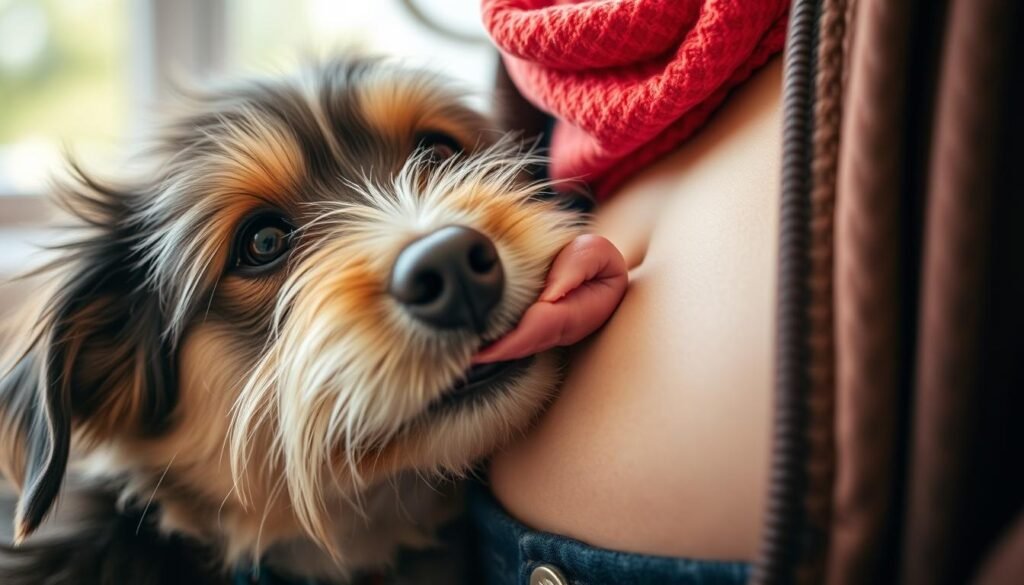- Understanding Your Dog's Feelings About Being Lifted
- Do Dogs Like Being Picked Up? The Truth Revealed
- Physical Signs Your Dog Enjoys Being Held
- Why Some Dogs Resist Being Lifted
- The Right Way to Pick Up Your Dog
- Building Trust Before Lifting Your Dog
- Health Considerations When Lifting Dogs
- Special Circumstances: When Lifting is Necessary
- Breed-Specific Considerations for Lifting
- Conclusion: Creating a Positive Lifting Experience
- FAQ
- Is it okay to pick up my dog?
- How can I understand my dog's feelings about being lifted?
- Do all dogs enjoy being picked up?
- What are the physical signs that my dog enjoys being held?
- Why do some dogs resist being lifted?
- What is the right way to pick up my dog?
- How can I build trust with my dog before lifting them?
- What health considerations should I keep in mind when lifting my dog?
- When is it necessary to lift my dog?
- Are there breed-specific considerations for lifting my dog?
Did you know small breed dogs often feel anxious more than big ones? Picking them up might seem like a natural thing to do for owners. But, it’s key to think about if dogs like being picked up and how they react. Some dogs might feel uneasy or scared when lifted.
Seeing a big dog coming, and it’s off-leash or excited, picking up your small dog can prevent injuries. Yet, some small dogs might not like being lifted because of discomfort, fear, or pain. It’s important to understand how dogs react to being picked up and why they might not enjoy it.

When deciding if you should pick up your dog, remember to make it a positive experience for them. Teaching your dog to see being picked up as a good thing can make them feel better. Using trick training can be a good way to help small dogs stay safe without picking them up. It’s important to consider if dogs like being picked up in this situation.
Understanding Your Dog’s Feelings About Being Lifted
It’s key to know how your dog feels about being lifted. Dogs, like people, have their own likes and dislikes about touch. The right way to pick up a dog is to support their chest and back, making them feel safe and calm. But, not all dogs like being lifted, and their past experiences affect their feelings.
Smaller dogs are often used to being held because of their size. Larger dogs might find being lifted strange and uncomfortable. You should think about your dog’s personality and comfort level before lifting them. If unsure, start by letting them get used to touch and then lifting them.

Lifting your dog should always be about their comfort and safety. Not all dogs like being lifted. Some might feel scared or stressed, while others enjoy the attention. Watch your dog’s body language and behavior to see if they’re relaxed and calm when lifted.
Natural Canine Behaviors and Instincts
Dogs have natural instincts and behaviors that affect how they see being lifted. For example, some dogs with a strong prey drive might get excited or anxious when lifted. Knowing these instincts helps you understand your dog’s feelings better and adjust how you lift them.
How Dogs Perceive Being Off the Ground
Dogs see being lifted differently based on their experiences and personalities. Some dogs feel free and excited, while others might feel scared or disoriented. By understanding your dog’s unique view, you can make lifting them a more enjoyable and stress-free experience.
The Role of Early Experiences
Early experiences greatly shape a dog’s feelings about being lifted. Dogs that have had positive experiences with being handled and lifted are more likely to feel comfortable. Dogs with negative experiences might develop anxiety or fear. By giving your dog positive and gentle handling from an early age, you can help them enjoy being lifted.
Do Dogs Like Being Picked Up? The Truth Revealed
When picking up your dog, think about their feelings and limits. Learning how to safely pick up a dog is key to a better pet relationship. Some dogs love being lifted, but others don’t. Spotting signs that a dog is uncomfortable being picked up, like yawning or looking away, helps you adjust.
Dogs being lifted is a sensitive topic. It’s vital to focus on their comfort and safety. Knowing your dog’s likes and dislikes helps make lifting more positive for both of you. Avoid mimicking mother dogs picking up pups, as it can hurt your dog.
Always watch your dog’s body language and actions. If they seem tense or try to move away, stop and give them space. Being aware of your dog’s feelings and limits builds trust and strengthens your bond.

Every dog is different, and what works for one might not for another. By understanding your dog’s unique needs and preferences, you can make lifting more enjoyable for both of you. Whether learning how to safely pick up a dog or improving your pet relationship, always put their comfort first.
Physical Signs Your Dog Enjoys Being Held
Understanding how dogs react to being held is key. Look for physical signs that show your dog is happy and relaxed. Some dogs prefer being carried in certain ways, while others might not like it at all.
Positive signs include a relaxed posture, a wagging tail, and leaning into the person holding them. These show your dog is comfortable and enjoying the contact. But, warning signs like panting, avoiding eye contact, or trying to squirm away mean your dog might be anxious or stressed. Knowing how pets feel when picked up helps build trust and ensures a good experience for both you and your dog.
Here are some key signs to look out for:
- A relaxed posture, with a loose and open body
- A wagging tail, which can indicate excitement and happiness
- Leaning into the person holding them, which can suggest affection and comfort
- Soft, relaxed facial expressions, with a calm and peaceful demeanor
By recognizing these signs and respecting your dog’s preferences and boundaries, you can make sure both you and your dog have a good time. Always put your dog’s comfort and consent first. Never force them into a situation that might stress or scare them.

| Sign | Indication |
|---|---|
| Relaxed posture | Comfort and relaxation |
| Wagging tail | Excitement and happiness |
| Leaning into the person | Affection and comfort |
| Soft, relaxed facial expressions | Calm and peaceful demeanor |
Why Some Dogs Resist Being Lifted
Every dog is different, and how they react to being picked up can vary a lot. Some dogs love being cuddled, while others may not like it. This could be due to fear, anxiety, or past experiences. To understand your dog better, let’s look at why some dogs don’t like being lifted.
Dogs are built to run fast and flee when scared. This makes them uneasy when lifted or held back. Also, things like vet visits can be scary for them. This might make them associate being picked up with bad experiences.
Signs a dog doesn’t like being held include turning their head, showing whites of the eyes, and pulling their ears back. Lip licking and yawning are also signs. If you see these, it’s important to respect their space. Knowing why dogs don’t like being lifted helps you pick them up in a way that’s less stressful for them.

Dogs have their own ways of showing affection. What one dog likes, another might not. Paying attention to how your dog acts and what they like can help you bond better.
Understanding why dogs don’t like being lifted can make interactions better for them. By knowing the reasons and addressing them, you can build a stronger bond with your dog. This helps create a more positive experience for both of you.
| Signs of Discomfort | What to Do |
|---|---|
| Turning head away | Give your dog space |
| Showing whites of the eyes | Avoid direct eye contact |
| Pulling ears back | Be gentle and calm |
The Right Way to Pick Up Your Dog
Picking up your dog needs to be done with care for their physical and emotional health. Knowing the best ways to pick up a dog can prevent injuries and make the experience better for both you and your pet. Start by understanding your dog’s body language and recognizing when they’re uncomfortable.
Experts like veterinarian Lauren Adams, DVM, say it’s key to read a dog’s body language. Look for signs like a relaxed posture, wagging tail, and calm demeanor. If you’re not sure how to pick up your dog safely, support their chest and back end, as vets like Jo Myers, DVM, recommend.
Support Points for Safe Lifting
To lift your dog safely, focus on supporting their body, mainly their chest and back end. This is vital for larger breeds, which might need two people to lift safely. Dr. Adams suggests using two people for heavier dogs to avoid straining your back and keep your dog safe.
Size-Specific Lifting Techniques
Different breeds and sizes need unique lifting techniques. Small dogs can be scooped up gently, while larger dogs need more support and care. When deciding if you should pick up a dog, think about their size, age, and health. Puppies need careful picking up before they get all their vaccinations, and pregnant dogs should be avoided to prevent discomfort or harm.
By following these guidelines and considering the best ways to pick up a dog, you can make the experience safe and enjoyable for your pet. Always put your dog’s comfort and well-being first. If you’re unsure, ask for advice from veterinarians.
Building Trust Before Lifting Your Dog
When lifting your dog, it’s key to think about their feelings. Not all dogs like being lifted, and some might show stress or discomfort. Building trust with your dog means creating a strong bond and making lifting a positive experience.
Training and positive reinforcement are great ways to start. Teach your dog basic commands and reward them with treats and praise. This makes them feel more secure and confident, helping them accept being lifted better.
Here are some tips to build trust with your dog:
- Start with short lifting sessions and gradually increase the time
- Use treats and praise to encourage good behavior
- Be gentle and careful when lifting to avoid causing stress
By following these tips, you can make lifting more comfortable for your dog. Remember, every dog is unique. With patience, consistency, and positive reinforcement, you can create a strong bond and make lifting a positive experience for both of you.
| Training Method | Benefits |
|---|---|
| Positive Reinforcement | Encourages good behavior, builds trust and confidence |
| Clicker Training | Helps with basic obedience behaviors, improves communication |
Health Considerations When Lifting Dogs
When lifting dogs, it’s key to think about their health and physical needs. Signs that a dog is uncomfortable being picked up include squirming and trying to escape. Learning how to safely pick up a dog is very important.
Dogs being lifted need careful thought about their size, weight, and breed. Dogs over 15kg should be lifted by two people to avoid back injury. Small dogs can be lifted with one arm, but it’s important to support their hind end to prevent back problems.
Here are some tips for lifting dogs safely:
- Support the dog’s back and legs
- Use the minimum amount of restraint necessary
- Avoid lifting dogs by their legs, scruff, or collar
By following these tips and considering your dog’s health and comfort, you can ensure a positive experience. Always put your dog’s safety and well-being first. If you’re unsure about lifting your dog, seek professional advice.
| Dog Size | Lifting Method |
|---|---|
| Small | One arm, supporting hind end |
| Medium | Two people, one for front and back |
| Large | Two people, one for front and back, with proper weight support |
Special Circumstances: When Lifting is Necessary
It’s important to know when lifting your dog is necessary. This might be in medical situations, emergencies, or with elderly or injured dogs. Understanding these times helps you pick up your dog in a way that’s good for them.
When thinking about if dogs like being picked up, remember each dog is different. Their size, age, and health can affect how they react. For example, big dogs might need two people to lift safely, while small dogs like Dachshunds can be lifted by one person using a special technique.
Medical Situations
In medical situations, you must handle your dog carefully to avoid hurting them more. Don’t lift them by the front legs or right under the armpits. Instead, use a supportive device or get help from a vet or trained professional.
Emergency Scenarios
In emergencies, time is of the essence. You need to lift your dog quickly and safely. If your dog is hurt or in trouble, focus on making them comfortable. Use a blanket or towel to support their body and prevent more harm.
Elderly or Injured Dogs
When dealing with older or injured dogs, be extra gentle and careful. Watch for signs they don’t like being held, like avoiding being picked up or showing stress. By understanding these signs and taking the right steps, you can make lifting your dog a positive and safe experience for them.
Breed-Specific Considerations for Lifting
When lifting your dog, it’s key to think about their breed. Different breeds have unique needs and likes. Knowing these can help you pick up your dog safely and comfortably.
Small dogs tend to be more anxious and excited than big dogs. So, it’s important to be gentle with them. Breeds like German Shepherds, Huskies, and Doodles might get more upset around other dogs. This is because of their looks and lively nature.
When deciding how to lift your dog, remember these traits. Ask yourself, should you pick up a dog that might get upset or anxious?
To pick up a dog safely, know their personality and needs. A dog’s breed only tells a small part of their behavior. So, getting to know your dog as an individual is vital.
- Size and weight
- Breed-specific characteristics
- Individual personality and needs
- Physical traits, such as upright/pointed ears and broad muscly chests
By considering these points, you can pick up your dog safely and make sure they have a good time.
Conclusion: Creating a Positive Lifting Experience
Creating a positive experience when picking up your dog is key. Understanding how to support them properly and recognizing when they’re uncomfortable is important. Building trust through gradual training helps too.
Smaller breeds might be used to being held, but larger dogs might find it strange and uncomfortable. It’s all about understanding your dog’s needs.
If your dog shows signs of distress or aggression when lifted, seek help from a professional dog trainer or behaviorist. They can help you address the issues and make lifting a positive experience. With patience, positive reinforcement, and respect for your dog’s boundaries, you can create a stress-free lifting experience for both you and your furry friend.
FAQ
Is it okay to pick up my dog?
Picking up your dog can be tricky. Some dogs don’t mind, while others might feel anxious. It’s important to know your dog’s personality and needs before picking them up.
How can I understand my dog’s feelings about being lifted?
Understanding your dog’s feelings about being lifted is key. Dogs have instincts that affect how they feel. Knowing these can help you see things from their perspective.
Do all dogs enjoy being picked up?
Not all dogs like being picked up. Look for signs like yawning or looking away. These can show they’re not comfortable.
What are the physical signs that my dog enjoys being held?
Knowing if your dog enjoys being held is important. Look for relaxed body language or a wagging tail. These signs show they’re okay with being picked up.
Why do some dogs resist being lifted?
Some dogs resist being lifted for reasons like fear or past experiences. Understanding these can help you pick them up in a way that’s less stressful.
What is the right way to pick up my dog?
Picking up your dog needs careful thought. It’s about their physical and emotional well-being. Doing it right can prevent injury and make it a good experience.
How can I build trust with my dog before lifting them?
Building trust with your dog is key before lifting them. Use training and positive reinforcement. This can make them more comfortable with being picked up.
What health considerations should I keep in mind when lifting my dog?
When lifting dogs, their health is very important. Knowing this can help prevent injury and make the experience better for them.
When is it necessary to lift my dog?
In some cases, like medical emergencies, lifting your dog is necessary. Understanding these situations can help you pick them up in a way that’s less stressful.
Are there breed-specific considerations for lifting my dog?
Different breeds have different needs when it comes to being lifted. Knowing these can help you pick them up in a way that’s more comfortable for them.






